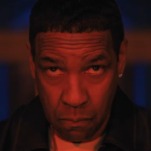Sylvan Esso Master Purposeful Pop
Photo by Shervin Lainez
The last song on Sylvan Esso’s 2014 self-titled debut is appropriately called “Come Down.” After nine tracks of inventive electro-pop, synth wizard Nick Sanborn manipulates the octaves of singer Amelia Meath’s voice over soft, pitched buzzing until 45 seconds of fading feedback closes out the record.
Three years later, a mild crackle opens the duo’s ambitious new album, What Now. “Sound” fuzzes and glitches for over 30 seconds before lyrical traces begin to emerge from the sonic rubble. By the sixth repetition, the layers fall away, the vocals crystalize and only Meath’s epigram remains.
“I was gonna write a song for you
Gonna sing it out loud
Gonna sing it at such decibels that
All you’ll hear is sound and
All you’ll feel is sound and
All you’ll be is sound”
Playing the two records in succession, “Sound” sounds like the epilogue to “Come Down.” Or maybe it’s the sound of the predecessor moving toward its new beginning.
On a recent afternoon over avocado toasts (his with beets, hers with bacon) at an Australian restaurant in Lower Manhattan, Sanborn lets out a Napoleon Dynamite-worthy “Yesshhh” in response to that notion. Meath simultaneously throws her arms up with glee, emitting a drawn out “Thank youuu!”
The two pride themselves on intentionality in their work as Sylvan Esso, a project they began almost accidentally four years ago in Durham, N.C. Each transition—from album to album, song to song, verse to chorus—is made with a purpose they hope listeners seek out in their music. As for “Come Down” and “Sound,” Sanborn describes them as such: “It’s like the last thing fell asleep and this is the sleepy waking up.”
Like their musical transitions, the conversational cues between Sanborn and Meath are naturally fluid. Describing the creation of “Sound,” Sanborn begins, “She had written that loop…” before Meath interjects to clarify: “While I was peeing.” Pausing to laugh into his Texas-sized toast, Sanborn continues, “She sang it that many times and then…I immediately wrote that chord progression to it.”
Even if “Sound” is a tenuous buffer between projects, it certainly served as a breakthrough during a particularly tough real-life transition for the band. “When that song came together—it came together in one afternoon—it was a light bulb,” says Sanborn.
“Like a signpost for the record,” adds Meath, as the two complete each other’s sentences.
“The minute we had that, we knew it had to be the first song, and then it informed every other decision we made about the record.”
-

-

-

-

-

-

-

-

-

-

-

-

-

-

-

-

-

-

-

-

-

-

-

-

-

-

-

-

-

-

-

-

-

-

-

-

-

-

-

-








































